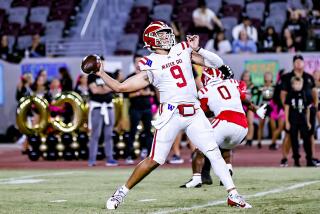Crenshaw and De La Salle: different paths to storybook seasons
- Share via
Both teams wear uniforms adorned with a familiar swoosh.
Only one set is provided complimentary by the company that makes them.
Both teams have legendary coaches.
Only one is showcased on his own page inside a glossy, quarter-inch-thick season program.
Both teams have had storybook seasons.
Only one has had its touchdowns chronicled by a play-by-play radio broadcaster.
The biggest high school football game in California this year appears to be an even matchup in terms of talent.
But when it comes to resources, the CIF state championship Open Division bowl game tonight at Home Depot Center between Los Angeles Crenshaw and Concord De La Salle is a running-clock-in-the-second-quarter rout.
De La Salle has amenities that would make some small college football programs envious. Crenshaw has to beg for basics.
“See all these jerseys these kids are wearing?” Cougars Coach Robert Garrett said this week, gesturing toward his players gathered in Crenshaw’s gymnasium. “It didn’t come from any budget because the budget can’t pay for it.
“It came from some people like [alumnus Kabeer Gbaja-Biamila] saying, ‘Coach, you need jerseys? I guess I’ll buy them this time.’ ”
No one has to pull out a checkbook when it comes to outfitting De La Salle players, who are swaddled in free Nike gear through a sponsorship deal with the apparel giant. Coaches are provided caps and windbreakers.
The Spartans enjoy other perks rarely found at inner-city schools. At a media event at the Home Depot Center on Monday, Luther Waters, Crenshaw’s assistant principal in charge of athletics, held up a copy of De La Salle’s 80-page program.
“Have you ever seen something like this from Crenshaw High?” Waters asked rhetorically.
De La Salle also has its own Web page, several paid assistant coaches and a professional videographer who had recorded 250 consecutive games going into this season. The Spartans even have a sports information director.
Crenshaw’s game programs consist of a couple of photocopied rosters stapled together with a cover page. All 13 of the Cougars’ assistant coaches are volunteers. A student videotapes games.
Advantage, De La Salle?
“It makes a difference,” Garrett said of his program’s lack of resources, “but you don’t worry about it because it’s the cards you were dealt.”
De La Salle Coach Bob Ladouceur scoffed at the notion that uniforms and a radio announcer provide an edge, saying “all you need is a weight room. . . . All that other stuff doesn’t mean anything.”
Officials from both schools declined to divulge their football budgets, though Waters conceded that Crenshaw’s is “not much at all. You’re probably looking at a few thousand dollars. . . . I wouldn’t consider it a budget.”
Crenshaw’s program is so strapped that it couldn’t help players whose families did not have $15 for tickets to tonight’s game. Waters placed a call to a local media outlet seeking help, prompting former USC receiver Keary Colbert and scores of De La Salle parents to offer financial assistance.
Scrounging up tickets is the least of the concerns for some Crenshaw players.
Many live in crime-plagued South Los Angeles neighborhoods and receive free or reduced-price school lunches because their families fall below the poverty line.
Rarely a day goes by when Garrett doesn’t house a player for the night so he can counsel them through some personal misfortune.
Then there’s De La Salle.
Nestled in a middle-class suburb of Oakland, the private Catholic school has blossomed into an academic and athletic juggernaut.
Last year, 99% of the graduating class went to college, with 81% attending four-year schools.
(By comparison, Waters estimated that between 65% and 70% of Crenshaw’s most recent graduating class went to college.)
Cougars receiver Gregory Ducre said he knew about De La Salle before high school because of the Spartans’ 151-game winning streak from 1992 through 2004 and the school’s legacy of producing NFL players such as Amani Toomer and Maurice Jones-Drew. Tonight will mark De La Salle’s unprecedented fourth consecutive bowl appearance.
Longtime Spartans assistant coach Terrell Ward Sr., whose son, Terron, is a senior running back/defensive back, said the team’s success stems not from resources but “a commitment from the coaching staff that trickles down.”
“It’s a private school, but it’s not like we have these great financial resources,” Terrell Ward said. “If you came to our campus and saw our weight room, you would say, ‘Wow, this is where it started?’ ”
Crenshaw has a refurbished weight room made possible by an $80,000 donation from Gbaja-Biamila, the former Green Bay Packers defensive end, but Garrett laments that few others in the community seem willing to help.
“I don’t know what support means nowadays,” said Garrett, who spent $6,000 out of his own pocket for a blocking sled and a tackling dummy.
Like De La Salle, Crenshaw has a stadium with relatively new artificial turf and a top-notch training staff on the sideline. The Cougars might even have one thing their counterparts don’t: a retired software engineer who serves as an unofficial team photographer, distributing free pictures to players after games.
Crenshaw players say they don’t worry about resources. The Cougars have not only persevered but thrived this season, becoming the first Los Angeles City Section team to participate in a bowl game since the state championships started in 2006.
“We’re just going to play with what we have,” quarterback Marquis Thompson said. “What we have is all we need.”
More to Read
Get our high school sports newsletter
Prep Rally is devoted to the SoCal high school sports experience, bringing you scores, stories and a behind-the-scenes look at what makes prep sports so popular.
You may occasionally receive promotional content from the Los Angeles Times.







